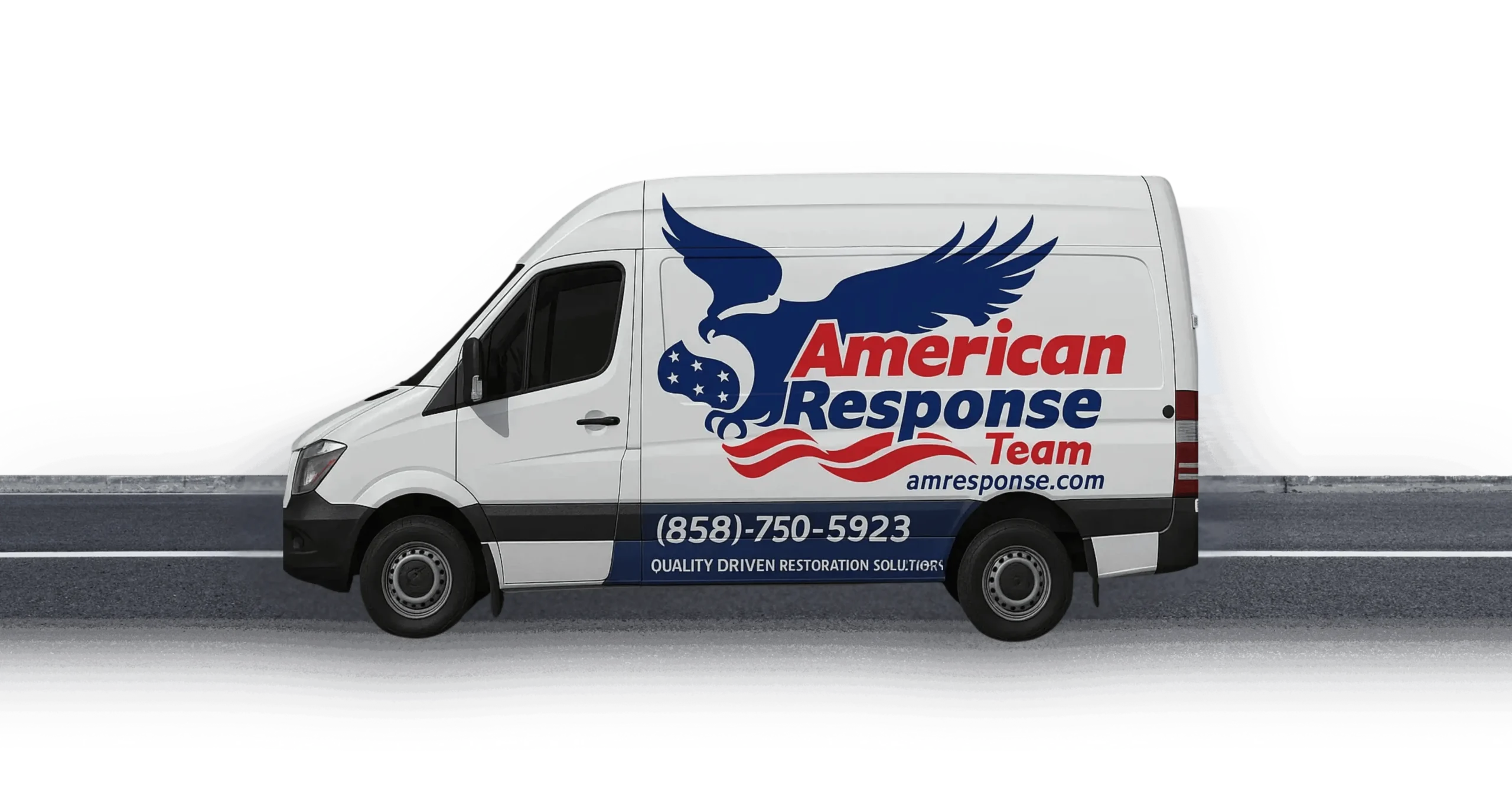Water damage can turn your day upside down in seconds. But once the water stops flowing, you’re probably wondering: how long does it take to dry out water damage? The answer isn’t as simple as you might think. Several important factors control how fast your home gets back to normal.
Understanding how long does it take to dry out water damage helps you plan better. It also helps you know what to expect from your water damage restoration team. Let’s look at the seven key factors that determine drying times.
1. Type of Water That Caused the Damage
Not all water is the same when it comes to damage. Clean water from a broken pipe dries faster than dirty water from a flood. This makes a huge difference in how long does it take to dry out water damage.
The IICRC S500 Standard puts water damage into three categories. Category 1 is clean water. This comes from things like broken water pipes or overflowing sinks. Category 2 is gray water that might have some germs. Category 3 is black water that’s very dirty and dangerous.
Clean water damage usually takes 3 to 5 days to dry completely. But contaminated water takes much longer. The restoration team needs extra time to clean and sanitize everything safely. This can add several days or even weeks to the process.
2. How Much Water Got Into Your Home
The amount of water affects how long does it take to dry out water damage. A small leak under your sink creates less damage than a burst pipe flooding your whole basement. More water means more drying time.
According to FEMA flood restoration guidelines, rooms with excellent ventilation can take 2 to 4 weeks to dry after major flooding. Interior rooms without good airflow take even longer.
Small water damage from minor leaks might dry in just a few days. But major flooding that soaks walls, floors, and furniture can take weeks to dry properly. Your restoration team will use special equipment to speed up the process.
3. What Materials Got Wet
Different materials hold water for different amounts of time. This directly affects how long does it take to dry out water damage in your specific situation. Understanding material types helps set realistic expectations.
Hard surfaces like tile and concrete dry faster than soft materials. Carpet and padding soak up lots of water and take longer to dry. Wood floors can warp if they don’t dry quickly enough. Drywall absorbs water like a sponge and often needs replacement.
The EPA’s water damage cleanup guidelines recommend removing wet carpet and padding within 24 to 48 hours. This prevents mold growth and speeds up the overall drying process.
Common Materials and Their Drying Times
Tile floors might dry in 1 to 2 days with proper equipment. Hardwood floors can take 5 to 10 days if they can be saved. Wet drywall often needs replacement, which extends the timeline significantly. If you’re dealing with flood restoration, expect longer drying times for all materials.
4. Temperature and Humidity Levels
Weather conditions play a big role in how long does it take to dry out water damage. Warm, dry air helps water evaporate faster. Cold, humid conditions slow everything down.
Professional restoration teams use special dehumidifiers and heaters to control the environment. They create the perfect conditions for fast, safe drying. This equipment can cut drying time in half compared to just opening windows and hoping for the best.
San Diego’s mild climate usually helps with drying times. But during humid winter months or marine layer season, the process might take longer. Your restoration team adjusts their equipment based on current weather conditions.
5. How Fast You Act After Water Damage
Time is critical when dealing with water damage. The faster you start the drying process, the shorter the overall timeline becomes. This directly impacts how long does it take to dry out water damage.
Water keeps spreading and soaking into materials every minute you wait. After 24 hours, mold can start growing. After 48 hours, you might need to replace materials instead of drying them. Quick action saves time and money.
Professional teams like American Response Team offer emergency water damage response to start the process immediately. The sooner they arrive, the faster your home gets back to normal.
Why Every Hour Matters
In the first few hours, most materials can still be saved with proper drying. After 24 hours, some materials start to deteriorate. After 72 hours, you’ll likely need more reconstruction work. Understanding what happens if water damage is left untreated shows why speed matters so much.
6. Airflow and Ventilation in the Affected Area
Good airflow speeds up drying significantly. This affects how long does it take to dry out water damage more than most people realize. Air movement helps water evaporate from wet surfaces.
Rooms with windows and good natural ventilation dry faster. Closed spaces like closets and basements take much longer. Professional teams use industrial fans called air movers to create strong airflow patterns.
The restoration team will set up equipment to create the best airflow patterns. They might remove doors or open cabinets to improve air movement. Every improvement in airflow reduces the total drying time.
7. Professional Equipment vs. DIY Drying
The type of equipment used dramatically changes how long does it take to dry out water damage. Professional equipment is much more powerful than household fans and dehumidifiers.
Industrial dehumidifiers can remove hundreds of gallons of water from the air each day. Professional air movers create powerful airflow patterns that reach every corner. Moisture meters help track progress precisely.
Trying to dry water damage yourself usually takes much longer. Household equipment isn’t powerful enough for serious water damage. You might think it’s dry when moisture is still hiding in walls or under floors.
Professional Monitoring Makes a Difference
Professional teams monitor moisture levels daily. They adjust equipment placement and settings as needed. This scientific approach ensures complete drying in the shortest possible time. They also document everything for your insurance company.
What to Expect During the Drying Process
Now that you understand the factors, let’s talk about what actually happens during professional water damage restoration. This helps you understand how long does it take to dry out water damage in real-world situations.
Day one involves water extraction and initial setup. The team removes standing water and places drying equipment. Days two through five involve monitoring and adjusting equipment. The team checks moisture levels and moves equipment as needed.
Most water damage projects finish within a week if started quickly. However, major flooding or contaminated water can take several weeks. Your restoration team will give you realistic timelines based on your specific situation.
Signs That Drying Is Complete
Professional teams use moisture meters to confirm drying is complete. All materials must reach normal moisture levels before equipment is removed. This prevents future problems like mold growth or structural damage.
You shouldn’t rely on how things look or feel. Moisture can hide inside walls or under floors. Only professional testing can confirm that drying is truly complete.
When Drying Takes Longer Than Expected
Sometimes the answer to how long does it take to dry out water damage is longer than hoped. Several factors can extend the timeline beyond initial estimates.
Hidden moisture in wall cavities takes extra time to find and dry. High humidity weather slows the process. Discovering additional damage during the work adds time. Contaminated water requires extra cleaning steps.
If mold appears after water damage, the timeline extends significantly. Mold remediation must happen before reconstruction can begin. This is why quick action and proper drying are so important.
Insurance and Timeline Considerations
Your insurance company wants the job done right, not just fast. They prefer longer drying times over callbacks for mold problems later. Understanding average insurance payouts for water damage helps you understand their priorities.
Preventing Future Water Damage
While we’ve covered how long does it take to dry out water damage, prevention is always better than restoration. Regular maintenance helps you avoid water damage emergencies.
Check your plumbing regularly for leaks. Clean gutters and downspouts to prevent water from entering your home. Know where your main water shut-off valve is located. Consider professional leak detection services for older homes.
Learn about common mistakes homeowners make after water damage. Knowing what not to do is just as important as knowing what to do.
Getting Professional Help Fast
When water damage strikes, don’t wait to get help. The longer you wait, the longer it takes to dry out water damage completely. Professional restoration teams can start the process immediately.
American Response Team provides 24/7 emergency response throughout San Diego County. Our certified technicians follow ANSI and IICRC standards for professional water damage restoration. We use the latest equipment and proven techniques to get your home dry quickly and safely.
We work directly with your insurance company to make the process smooth. Our team handles everything from initial assessment to final reconstruction. You can focus on getting your life back to normal while we handle the technical details.
Remember, how long does it take to dry out water damage depends on many factors. But with professional help, you can minimize the time and get the best possible results. Don’t let water damage turn into a bigger problem by waiting too long to act.
Contact American Response Team at our emergency hotline for immediate help with water damage restoration. Our experienced team is ready to help you through this difficult time with professional, caring service.

